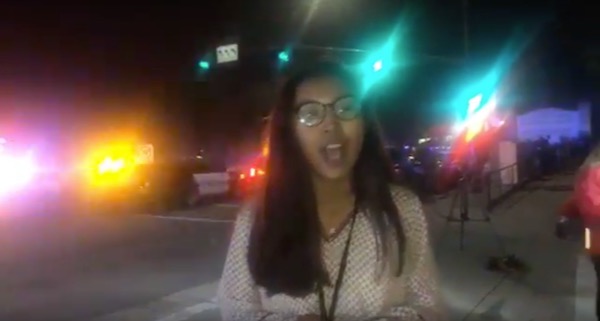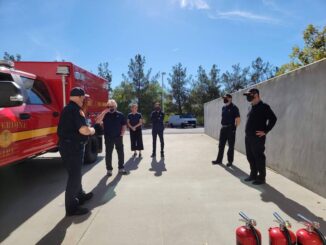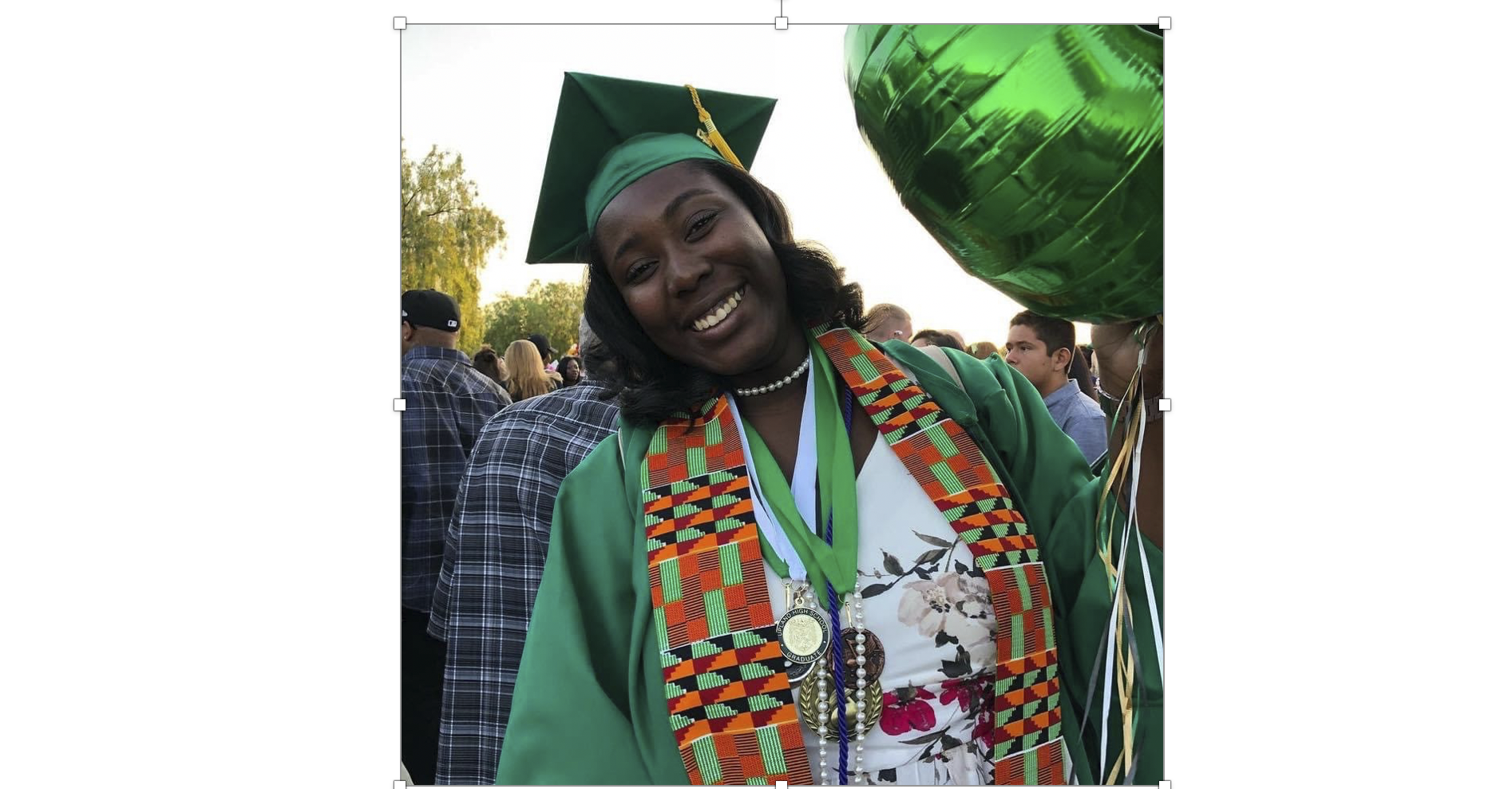
Nov. 7, 2018, 11:30 p.m.
Now senior journalism major Kaiyu Wong was hanging out in her room when she received texts from her friend regarding a shooting at Borderline Bar & Grill. After asking if her friend was OK, Wong knew she had to go cover the breaking news story.
“When I got to the scene of the shooting it took me a while to figure out what am I supposed to do now?” Wong said. “How am I supposed to go up to these people who literally just escaped death?”
Wong and now Pepperdine alumna Araceli Cresencio covered the press conference and talked with eyewitnesses, returning to campus at 6 a.m. Wong covered the announcement of Alaina Housley’s death, and they produced a NewsWaves special edition at 5 p.m.
Immediately after the show, student journalists shifted their coverage to the Woolsey fire.
Reflecting later, Wong said she struggled after the trauma coverage to pinpoint her feelings and what needed to be processed. Wong found that talking to people was the best way to cope.
“It was hard to be like this,” Wong said. “It was really hard for me because I did not experience [the Borderline shooting]; I covered a traumatizing event, but I was not in the traumatizing event, and it was hard to explain that. Coping with feeling guilt about having to talk to someone right after they nearly lost their life — I think those were the feelings I was dealing with.”
Wong was not alone. It was all hands on deck for her colleagues in Pepperdine Graphic Media and NewsWaves. Within 48 hours, the shooting and fire impacted everyone in these newsrooms. Those events have since impacted their reporting skills, their ability to cope, their social life and their health.
Research on trauma reporting
The emotional effects of covering trauma for journalists are becoming more widely discussed and studied.
Reporters who cover trauma can develop post-traumatic stress disorder (PTSD) symptoms, Roger Simpson and James Boggs wrote in a 1999 journal article. About 86% of the reporters they studied had covered one or more traumatic stories at the scene, including earthquakes, murders, executions, sexual assaults, drownings and plane crashes.
PTSD symptoms include sleeplessness, flashbacks of images and thoughts of the event, and reactions such as sweating and increased heart rate when reminded of a traumatic event, Jo Killeen wrote in her 2011 master’s thesis about journalists and PTSD.
Journalists and reporters are likely to get PTSD or undergo emotional stress when they do not debrief or find a healthy outlet to discuss what they have seen.
Kenna Griffin, a former journalist and a professor at the University of Oklahoma who studies the impact of trauma reporting, wrote in her blog, Prof KRG, that the best way to cope is by talking about it.
Griffin also said the signs of emotional trauma are not widely known, and that is a big part of why many reporters do not seek help and cases go unnoticed. For more information and resources, she points people to The National Center for PTSD.
Reporting on trauma
During the Borderline shooting, Wong and Cresencio left campus immediately. The reporters only had their phones and a few portable chargers. They did live broadcasts on Facebook. Wong said she learned how to improvise and use what she had to accomplish the reporting.
Madeleine Carr, a senior journalism major and now managing editor of The Graphic, was news editor at the time. After getting the initial texts of the shooting, she went to the PGM newsroom where she worked all night and through the next day to post content from Wong and Cresencio and take national press calls. She woke up Friday, Nov. 9 to shelter-in-place orders from Pepperdine and ended up spending that night on the floor of the Waves Cafe, reporting on what was happening.
When she finally left campus and returned home to Hawai’i, she and others in the Graphic newsroom produced their special edition remotely.
Sophomore journalism major Austin Hall woke up to the news of the shooting and went to the newsroom as soon as he could. Though a freshman at the time, producers sent him to the Los Robles Hospital, where victims were being treated.
Hall stayed at the hospital all day and gathered as much information as possible, going live from the scene during the special edition of NewsWaves.
He began to smell smoke as soon as the camera cut. He returned to campus and immediately went to interview a few students who were being evacuated from their off-campus housing.
During the traumatic events of Fall 2018, Elizabeth Smith, director of Pepperdine Graphic Media and communication professor, said the biggest shift she saw in the newsroom was how quickly everyone came together for each other. Everyone stepped up; people were helping in areas they were not assigned.
“It was sad that [the shooting and the fire] happened,” Smith said. “But it was one of the most meaningful things, seeing our ad director step in and help get quotes for the stories.”
Student journalists unanimously said their reporting skills have improved due to covering back-to-back major breaking news stories.
With the death of basketball legend, Kobe Bryant, Smith saw the same students from Borderline and Woosley cover the breaking news seamlessly. She said she is really proud they have developed the knowledge to argue with authorities regarding their press passes, that they have the right to cover breaking news and attend press conferences.
Makena Huey, a junior English major who is now Currents editor-in-chief, said covering the shooting and the fire taught her how to go about reporting in a respectful way. She said she has found balance between when it is the time to document and when to stand back.
“When the shooting happened, I was told to like go to main campus and ask people for quotes about how they felt,” Huey said. “And that was right when we found out about everything, and some people were really mad at me. They were like, ‘This is not a time to be getting quotes. This isn’t the time to do your job,’ and I disagree. I think it is the time.”
Journalism students at Pepperdine regularly report campus news by finding sources, securing interviews, fact-checking and shooting footage. Many go to the scenes of breaking stories and get the footage themselves rather than from other accredited news sources.
A Pepp Post poll of 51 students found that 90% of students think journalism is a hard job.
Ability to cope: Strength in numbers
Being stressed is one thing, but coping with it is another. Between managing school, their stories, extracurriculars and working, student journalists may not find the time to reflect on past events.
Smith said she often sees the students struggling with certain deadlines. When she does notice students taking on too much, she recommends they get out of the newsroom and take a walk.
“We will often tell students to go outside, get out of the newsroom,” Smith said. “If you are feeling overwhelmed, it is probably because you have been in this room too long.”
Having a support system is vitally important, Faith Ozby and colleagues wrote in a 2007 study Social Support and Resilience to Stress. Positive social support can increase the rate individuals adapt to stressful situations and even counteract PTSD symptoms.
Carr went home to Hawaii after the shooting and fire. She found that it was nice to be with her family, but she really needed the support of those experiencing the same situation.
“While it was really great being with my family, it was really hard being around people who were not tied to the situation in any way,” Carr said.
Hall said the stress of the trauma and impact of the events did not hit him until later.
“It is a little tricky with emotions sometimes because you want to be out in the field or sort of a bystander that is not affected, but trying to report on the facts,” Hall said. “But it is always important to go home and reflect and pray.”
Having a support group is helpful and so is acknowledging them, he said.
“Tell your loved ones you love them,” Hall said. “That is really, really important.”
Effects on sleep and social life
“Sleep? I don’t sleep,” said Carlie Ott, senior journalism major and director for NewsWaves and Good Morning Malibu.
Ott laughed when she said this, but it came with a lot of truth.
“I have stayed in this building for 48 hours,” Ott said. “And only left to go to the main campus and that was for a class.”
Ott said she did not even go back to her room during the anniversary show of the Woosley fire, Strength Under Fire. She stayed up in the newsroom to edit videos.
Kaelin Mendez, a junior double majoring in journalism and psychology and now podcast editor for the Graphic, also found his sleep schedule to be out of place.
“Eating and sleeping, those are the ones that people should definitely not push aside,” Mendez said. “But those are the ones that I tend to push aside.”
The time spent doing journalism also impacts their social lives.
A popular outing the journalism students said they missed out on was “Taco Tuesday.” Most of their friends invite them to these kinds of activities and they pass it up to write and edit their stories.
The poll found that students were familiar with student media but tend to get the news from their friends or official campus emails.
About 57% of students only sometimes read stories from The Graphic.
Some of the journalists who give up sleep to produce a news show or write a story found it frustrating that the effort is not appreciated much.
“There is kind of a give and take of other people not really understanding what we do and not appreciating it,” Huey said. “Like a lot of my friends don’t even know what Currents magazine is or don’t read the Graphic.”
Applying it to life
Most of the student journalists found they learned about how stories connect people and shine light on bigger issues.
“I think one thing that is kind of missing from people’s perception of journalism is humanity,” Huey said. “I think that kind of goes on both sides, so a lot of people do not realize that journalists are human and the things that we report on and the stories we tell impact us just as much as they impact other people. But also I think that journalists have to remember that the subjects they are reporting on are also human.”
Mendez reflected on his role capturing photos of the aftermath of the Borderline shooting and how it has since impacted the way he approaches people.
“There is a good line between coverage of an event and prying on people’s emotions or exploiting people’s emotions that I definitely caught myself in,” Mendez said.
Mendez reflected on a pivotal moment in the chapel. He said he was sitting there and he saw people crying. He was supposed to be getting photographs, and he thought to himself that he wished one girl would turn her head.
“I was trying to get someone to cry right,” Mendez said.
Mendez also noted that when it comes to covering emotional events it is important to understand the people and the pain they are experiencing.
“There is a fine line between telling the story and then doing things that are not necessary to tell the story,” Mendez said. “So that is something that sticks with me, being able to tell the story correctly but also respecting other people’s emotions and feelings.”
Jennifer Berry Hawes, a Pulitzer prize winner and reporter for the Post and Courier in Charleston, South Carolina, wrote a nonfiction bestseller on the shooting that killed nine at the Emanuel African Methodist Episcopal Church. She offered her own advice for those interested in journalism and reporting on stories that may be traumatic.
“It is important to see it as a story you are going to tell as best as you can,” Hawes said. “But that ultimately people’s suffering is not your own suffering and you can’t adopt it as your own suffering or you won’t be able to do this job. You need to be able to see it as a story you are writing and that you’ve been entrusted with, but not one that you are going to carry on yourself as a trauma that you have experienced.”
Milan Alas completed the reporting for this story under the supervision of Dr. Christina Littlefield and Dr. Theresa de los Santos in Jour 241 in Spring 2020. Dr. Littlefield supervised the web story. Dr. de los Santos supervised the visual package.



